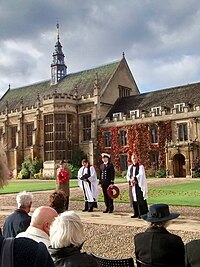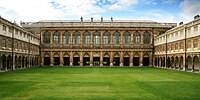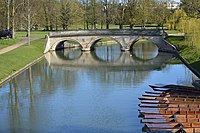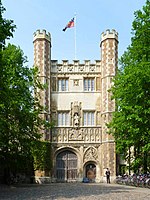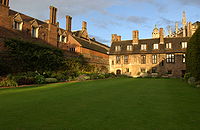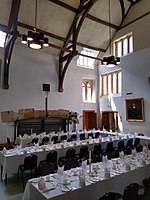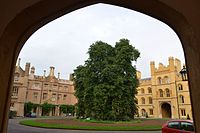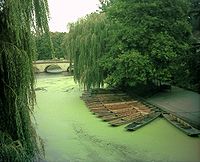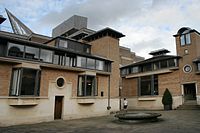Difference between revisions of "Trinity College, Cambridge"
(Created page with "{{Infobox college |name=Trinity College |county=Cambridgeshire |university=Cambridge |picture=Trinity College - Great Court 02.jpg |picture caption=Trinity College Great Cour...") |
(→Nevile's expansion) |
||
| Line 34: | Line 34: | ||
===Nevile's expansion=== | ===Nevile's expansion=== | ||
[[File:Trinity College Cambridge 1690.jpg|left|thumb|300px|David Loggan's print of 1690]] | [[File:Trinity College Cambridge 1690.jpg|left|thumb|300px|David Loggan's print of 1690]] | ||
| − | The monastic lands granted by Henry VIII were not on their own sufficient to ensure Trinity's eventual rise. In terms of architecture and royal association, it was not until the Mastership of Thomas Nevile (1593–1615) that Trinity assumed both its spaciousness and its association with the governing class that distinguished it since the Civil War. In its infancy Trinity had owed a great deal to its neighbouring college of [[St John's College, Cambridge|St John's]]: in the words of Roger Ascham, Trinity was a ''colonia deducta''.<ref name=b1> | + | The monastic lands granted by Henry VIII were not on their own sufficient to ensure Trinity's eventual rise. In terms of architecture and royal association, it was not until the Mastership of Thomas Nevile (1593–1615) that Trinity assumed both its spaciousness and its association with the governing class that distinguished it since the Civil War. In its infancy Trinity had owed a great deal to its neighbouring college of [[St John's College, Cambridge|St John's]]: in the words of Roger Ascham, Trinity was a ''colonia deducta''.<ref name=b1>{{VCH|3|The colleges and halls – Trinity College|pp=456-473#s20}}</ref> |
Most of Trinity's major buildings date from the 16th and 17th centuries. Thomas Nevile, who became Master of Trinity in 1593, rebuilt and redesigned much of the college. This work included the enlargement and completion of Great Court]] and the construction of Nevile's Court]] between Great Court and the [[River Cam]]. Nevile's Court was completed in the late 17th century with the [[Wren Library, Cambridge|Wren Library]], designed by Christopher Wren. Nevile's building campaign drove the college into debt from which it surfaced only in the 1640s, and the Mastership of Richard Bentley adversely affected applications and finances.<ref name=b1/> Bentley himself was notorious for the construction of a hugely expensive staircase in the Master's Lodge and for his repeated refusals to step down despite pleas from the Fellows. Besides, despite not being a sister college of [[Trinity College Dublin|Trinity College]] in Dublin, as is the case with [[St John's College, Cambridge|St John's College]], Cambridge, it is believed that the Irish institution takes its name from this college, which was the ''alma mater'' of its first provost, Adam Loftus and, likewise, from the Oxford [[Trinity College, Oxford|college]] of the same name. | Most of Trinity's major buildings date from the 16th and 17th centuries. Thomas Nevile, who became Master of Trinity in 1593, rebuilt and redesigned much of the college. This work included the enlargement and completion of Great Court]] and the construction of Nevile's Court]] between Great Court and the [[River Cam]]. Nevile's Court was completed in the late 17th century with the [[Wren Library, Cambridge|Wren Library]], designed by Christopher Wren. Nevile's building campaign drove the college into debt from which it surfaced only in the 1640s, and the Mastership of Richard Bentley adversely affected applications and finances.<ref name=b1/> Bentley himself was notorious for the construction of a hugely expensive staircase in the Master's Lodge and for his repeated refusals to step down despite pleas from the Fellows. Besides, despite not being a sister college of [[Trinity College Dublin|Trinity College]] in Dublin, as is the case with [[St John's College, Cambridge|St John's College]], Cambridge, it is believed that the Irish institution takes its name from this college, which was the ''alma mater'' of its first provost, Adam Loftus and, likewise, from the Oxford [[Trinity College, Oxford|college]] of the same name. | ||
Latest revision as of 18:58, 14 April 2024
| Trinity College Latin: Collegium Trinitatis
| |||||||||||||||
|
Virtus Vera Nobilitas | |||||||||||||||
|---|---|---|---|---|---|---|---|---|---|---|---|---|---|---|---|
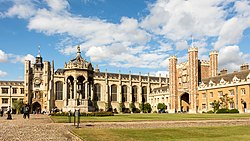 Trinity College Great Court | |||||||||||||||
| Master: | Sally Davies | ||||||||||||||
| Website: | trin.cam.ac.uk | ||||||||||||||
| |||||||||||||||
| Location | |||||||||||||||
| Grid reference: | TL44655864 | ||||||||||||||
| Location: | 52°12’25"N, 0°6’56"E | ||||||||||||||
Trinity College is a constituent college of the University of Cambridge. Founded in 1546 by King Henry VIII, Trinity is one of the largest of the Cambridge colleges, with the largest financial endowment of any Oxbridge college. Trinity performs exceptionally as measured by the Tompkins Table (the annual unofficial league table of Cambridge colleges), coming top from 2011 to 2017.[1] Trinity was the top-performing college for the 2020–21 undergraduate exams, obtaining the highest percentage of good honours.[2]
Members of Trinity have been awarded 34 Nobel Prizes out of the 121 received by members of the University of Cambridge (the highest of any college at either Oxford or Cambridge).
Contents
History
Foundation
The college was founded by Henry VIII in 1546, from the merger of two existing colleges: Michaelhouse (founded by Hervey de Stanton in 1324), and King's Hall (established by Edward II in 1317 and refounded by Edward III in 1337). At the time, Henry had been seizing church lands from abbeys and monasteries. The universities of Oxford and Cambridge, being both religious institutions and quite rich, expected to be next in line. The King duly passed an Act of Parliament that allowed him to suppress (and confiscate the property of) any college he wished. The universities used their contacts to plead with his sixth wife, Catherine Parr. The Queen persuaded her husband not to close them down, but to create a new college. The king did not want to use royal funds, so he instead combined two colleges (King's Hall and Michaelhouse) and seven hostels to form Trinity.
Nevile's expansion
The monastic lands granted by Henry VIII were not on their own sufficient to ensure Trinity's eventual rise. In terms of architecture and royal association, it was not until the Mastership of Thomas Nevile (1593–1615) that Trinity assumed both its spaciousness and its association with the governing class that distinguished it since the Civil War. In its infancy Trinity had owed a great deal to its neighbouring college of St John's: in the words of Roger Ascham, Trinity was a colonia deducta.[3]
Most of Trinity's major buildings date from the 16th and 17th centuries. Thomas Nevile, who became Master of Trinity in 1593, rebuilt and redesigned much of the college. This work included the enlargement and completion of Great Court]] and the construction of Nevile's Court]] between Great Court and the River Cam. Nevile's Court was completed in the late 17th century with the Wren Library, designed by Christopher Wren. Nevile's building campaign drove the college into debt from which it surfaced only in the 1640s, and the Mastership of Richard Bentley adversely affected applications and finances.[3] Bentley himself was notorious for the construction of a hugely expensive staircase in the Master's Lodge and for his repeated refusals to step down despite pleas from the Fellows. Besides, despite not being a sister college of Trinity College in Dublin, as is the case with St John's College, Cambridge, it is believed that the Irish institution takes its name from this college, which was the alma mater of its first provost, Adam Loftus and, likewise, from the Oxford college of the same name.
Modern day
In the 20th century, Trinity College, St John's College and King's College were for decades the main recruiting grounds for the Cambridge Apostles, an elite, intellectual secret society. In 2011, the John Templeton Foundation awarded Trinity College's Master, the astrophysicist Martin Rees, its controversial million-pound[4] Templeton Prize, for "affirming life's spiritual dimension". Trinity is the richest Oxbridge college with a landholding alone worth £800 million.[5] In 2005, Trinity's annual rental income from its properties was reported to be in excess of £20 million.
Trinity has some of the most distinctive architecture in Cambridge with its Great Court said to be the largest enclosed courtyard in Europe.[6]
Buildings and grounds
Great Gate
The Great Gate is the main entrance to the college, leading to the Great Court. A statue of the college founder, Henry VIII, stands in a niche above the doorway. In 1704, the University's first astronomical observatory was built on top of the gatehouse. Beneath the founder's statue are the coats of arms of Edward III, the founder of King's Hall, and those of his five sons who survived to maturity, as well as William of Hatfield, whose shield is blank as he died as an infant, before being granted arms.
Great Court
Great Court (built 1599–1608) was the brainchild of Thomas Nevile, who demolished several existing buildings on this site, including almost the entirety of the former college of Michaelhouse. The sole remaining building of Michaelhouse was replaced by the then current Kitchens (designed by James Essex) in 1770–1775. The Master's Lodge is the official residence of the Sovereign when in Cambridge. King's Hostel (built 1377–1416) is located to the north of Great Court, behind the Clock Tower. This is, along with the King's Gate, the sole remaining building from King's Hall. Bishop's Hostel (built 1671) is a detached building to the south-west of Great Court, and named after John Hacket, Bishop of Lichfield and Coventry. Additional buildings were built in 1878 by Arthur Blomfield.
Nevile's Court
Nevile's Court (built 1614) is located between Great Court and the river, this court was created by a bequest by the college's master, Thomas Nevile, originally two-thirds of its current length and without the Wren Library. The court was extended and the appearance of the upper floor remodelled slightly in 1758 by James Essex. Cloisters run around the court, providing sheltered walkways from the rear of Great Hall to the college library and reading room as well as the Wren Library and New Court.
Wren Library (built 1676–1695, Christopher Wren) is located at the west end of Nevile's Court, the Wren is one of Cambridge's most famous and well-endowed libraries. Among its notable possessions are two of Shakespeare's First Folios, a 14th-century manuscript of The Vision of Piers Plowman, letters written by Sir Isaac Newton, and the Eadwine Psalter.[7] Below the building are the pleasant Wren Library Cloisters, where students may enjoy a fine view of the Great Hall in front of them, and the river and the Backs directly behind.
New Court
New Court (or King's Court; built 1825, William Wilkins) is located to the south of Nevile's Court, and built in Tudor-Gothic style; this court is notable for the large tree in the centre. A myth is sometimes circulated that this was the tree from which the apple dropped onto Isaac Newton; in fact, Newton was at home in Woolsthorpe when he deduced his theory of gravity – and the tree is a horse chestnut tree.[8]
Chapel
Trinity College Chapel]] dates from the mid 16th century and is Grade I listed]].[9] There are a number of memorials to former Fellows of Trinity within the Chapel, including statues, brasses, and two memorials to graduates and Fellows who died during the World Wars. Among the most notable of these is a statue of Isaac Newton by Roubiliac, described by Sir Francis Chantrey as "the noblest, I think, of all our English statues." The Chapel is a performance space for the College Choir which comprises around thirty Choral Scholars and two Organ Scholars, all of whom are ordinarily students at the University.
Grounds
The Fellows' Garden is located on the west side of Queen's Road, opposite the drive that leads to the Backs. The Fellows' Bowling Green is located north of Great Court, between King's Hostel and the river. It is the site for many of the tutors' garden parties in the summer months, while the Master's Garden is located behind the Master's Lodge. The Old Fields are located on the western side of Grange Road, next to Burrell's Field. It currently houses the college's gym, changing rooms, squash courts, badminton courts, rugby, hockey and football pitches along with tennis and netball courts.
Trinity Bridge
Trinity Bridge is a stone built tripled-arched road bridge across the River Cam. It was built of Portland stone in 1765 to the designs of James Essex to replace an earlier bridge built in 1651 and is a Grade I listed building.[10]
Pictures
Great Court Run
The Great Court Run requires a circuit of the 400-yard perimeter of Great Court, in the 43 seconds of the clock striking 12. The time varies according to humidity. Students traditionally attempt to complete the circuit on the day of the Matriculation Dinner. It is a difficult challenge: one needs to be a fine sprinter to achieve it, but it is not necessary to be of Olympic standard, despite assertions made in the press.
It is widely believed that Sebastian Coe successfully completed the run when he beat Steve Cram in a charity race in October 1988. Coe's time on 29 October 1988 was reported by Norris McWhirter to have been 45.52 seconds, but it was actually 46.0 seconds, while Cram's was 46.3 seconds. The clock on that day took 44.4 seconds and the video film confirms that Coe was some 12 metres short of the finish line when the final stroke occurred. The television commentators were wrong to speculate that the dying sounds of the bell could be included in the striking time, thereby allowing Coe's run to be claimed as successful. One reason Olympic runners Cram and Coe found the challenge difficult is that they started at the middle of one side of the court, having to negotiate four right-angle turns. In the days when students started at a corner, only three turns were needed. In addition, Cram and Coe ran entirely on the flagstones, while until 2017 students have typically cut corners to run on the cobbles.
The Great Court Run was portrayed in the film Chariots of Fire about the British Olympic runners of 1924. The run was filmed at Eton College in Berkshire, not in Great Court. Until the mid-1990s, the run was traditionally attempted by first-year students at midnight following their matriculation dinner. Following a number of accidents to undergraduates running on slippery cobbles, the college now organises a more formal Great Court Run, at 12 noon on the day of the matriculation dinner: while some contestants compete seriously, many others run in fancy dress and there are prizes for the fastest man and woman in each category.
Outside links
| ("Wikimedia Commons" has material about Trinity College, Cambridge) |
- Trinity College
- Trinity College Isaac Newton Trust, established in 1988
- Paintings at Trinity College, Cambridge, ArtUK project.
- Trinity in Japan
References
- ↑ "Exclusive: Christ's triumphant in 2019 Tompkins Table". https://www.varsity.co.uk/news/17736.
- ↑ "Results by College Dashboard". 15 August 2018. https://www.information-hub.admin.cam.ac.uk/university-profile/ug-examination-results/results-college-dashboard.
- ↑ 3.0 3.1 A History of the County of Cambridgeshire - Volume 3 pp 456-473#s20: The colleges and halls – Trinity College (Victoria County History)
- ↑ Sample, Ian (6 April 2011). "Martin Rees wins controversial £1m prize". The Guardian. https://www.theguardian.com/science/2011/apr/06/martin-rees-templeton-prize.
- ↑ "Oxford and Cambridge university colleges hold £21bn in riches". 28 May 2018. https://www.theguardian.com/education/2018/may/28/oxford-and-cambridge-university-colleges-hold-21bn-in-riches.
- ↑ Stephen Brewer, Donald Olson (2006). Best Day Trips from London: 25 Great Escapes by Train, Bus Or Car. Frommer's. p. 56. ISBN 0-470-04453-5.
- ↑ "Library". https://www.trin.cam.ac.uk/library/home/.
- ↑ "Trinity College Cambridge – Dutch Master". 18 January 2019. https://www.pitchcare.com/news-media/dutch-master.html.
- ↑ National Heritage List 1106371: Trinity College Chapel (Grade I listing)
- ↑ National Heritage List 1331804: Trinity College, Trinity Bridge (Grade I listing)
| Colleges of the University of Cambridge | |
|---|---|
|
Christ’s • Churchill • Clare • Clare Hall • Corpus Christi • Darwin • Downing • Emmanuel • Fitzwilliam • Girton • Gonville and Caius • Homerton • Hughes Hall • Jesus • King’s • Lucy Cavendish • Magdalene • Murray Edwards • Newnham • Pembroke • Peterhouse • Queens’ • Robinson • St Catharine’s • St Edmund’s • St John’s • Selwyn • Sidney Sussex • Trinity • Trinity Hall • Wolfson |
|




